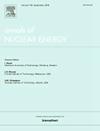High-burnup boiling water reactor steady-state operating conditions and fuel performance analysis
IF 1.9
3区 工程技术
Q1 NUCLEAR SCIENCE & TECHNOLOGY
引用次数: 0
Abstract
The primary operational costs for existing nuclear reactors are plant operation costs, maintenance costs, and fuel costs, all of which are influenced by the materials used and the design of the reactor core. Optimizing core design parameters—including burnup limits and enrichment levels—can lengthen cycles, reduce outages, reduce reload batch fractions and spent fuel storage requirements, and lower maintenance and operating expenses, thereby enhancing economic viability. Furthermore, developing higher-fidelity tools to simulate these parameters enables better identification of the available margin, improves overall plant safety, and improves the understanding a given plant’s responses to accident scenarios. In the US, much of the research and development focus has traditionally been on pressurized water reactors (PWRs), but boiling water reactors (BWRs) comprise approximately one-third of the US reactor fleet. Modeling and simulation advances for BWRs and PWRs—particularly those achieved through the Nuclear Energy Advanced Modeling and Simulation (NEAMS) program—are crucial to the long-term viability of the light–water reactor industry. A key research area of the high burnup and increased enriched fuel initiative is focused on addressing issues related to postulated loss-of-coolant accident (LOCA) scenarios. NEAMS has dedicated significant effort to enhancing tools to better support BWRs. A current focus is showcasing the BWR framework for high-burnup LOCA analysis. This high-fidelity steady-state analysis is a first step toward demonstrating a best-estimate, pin-by-pin high-burnup BWR LOCA analysis to assess full-core cladding rupture behavior for a representative BWR. The objective of this effort is to provide a modeling capability that will help elucidate and provide a best-estimate evaluation for cladding rupture susceptibility in BWRs. This modeling capability could then be used to prevent and/or mitigate cladding ruptures in postulated accident scenarios without penalizing operational parameters. Additionally, the results of this work will help identify strategies for finding additional margins or potentially limiting cladding ruptures through core design optimizations to enable more efficient core designs.
求助全文
约1分钟内获得全文
求助全文
来源期刊

Annals of Nuclear Energy
工程技术-核科学技术
CiteScore
4.30
自引率
21.10%
发文量
632
审稿时长
7.3 months
期刊介绍:
Annals of Nuclear Energy provides an international medium for the communication of original research, ideas and developments in all areas of the field of nuclear energy science and technology. Its scope embraces nuclear fuel reserves, fuel cycles and cost, materials, processing, system and component technology (fission only), design and optimization, direct conversion of nuclear energy sources, environmental control, reactor physics, heat transfer and fluid dynamics, structural analysis, fuel management, future developments, nuclear fuel and safety, nuclear aerosol, neutron physics, computer technology (both software and hardware), risk assessment, radioactive waste disposal and reactor thermal hydraulics. Papers submitted to Annals need to demonstrate a clear link to nuclear power generation/nuclear engineering. Papers which deal with pure nuclear physics, pure health physics, imaging, or attenuation and shielding properties of concretes and various geological materials are not within the scope of the journal. Also, papers that deal with policy or economics are not within the scope of the journal.
 求助内容:
求助内容: 应助结果提醒方式:
应助结果提醒方式:


